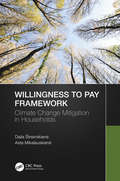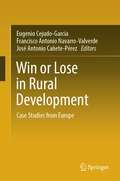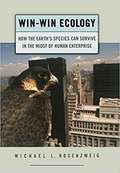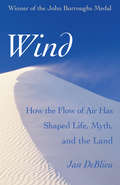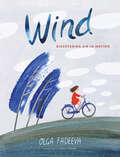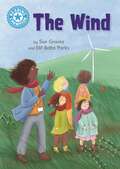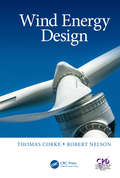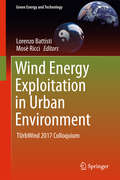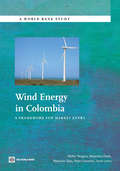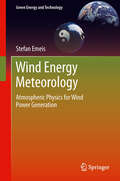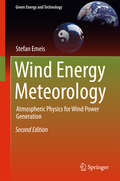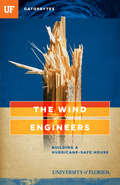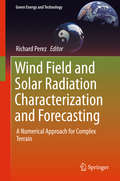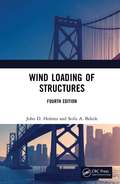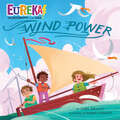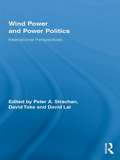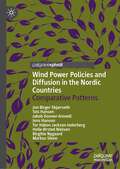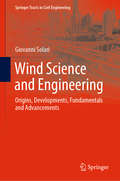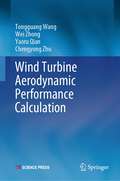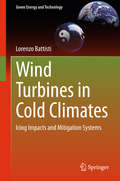- Table View
- List View
Will We Survive on Earth? (Brief Answers, Big Questions)
by Stephen Hawking'Be brave, be curious, be determined, overcome the odds. It can be done'Will we survive on Earth?Should we colonise space?Throughout his extraordinary career, Stephen Hawking expanded our understanding of the universe and unravelled some of its greatest mysteries. In Will We Survive on Earth? the world-famous cosmologist and bestselling author of A Brief History of Time turns his attention to one of the most urgent issues for humankind and explores our options for survival.'Effortlessly instructive, absorbing and witty' GuardianBrief Answers, Big Questions: this stunning paperback series offers electrifying essays from one of the greatest minds of our age, taken from the original text of the No. 1 bestselling Brief Answers to the Big Questions.
Willingness to Pay Framework: Climate Change Mitigation in Households
by Dalia Štreimikienė Asta MikalauskienėThis book aims to develop a framework for the assessment of population ‘preferences in climate change mitigation policies by applying a Willingness to Pay (WTP) approach and presents the results from several case studies in Lithuania on renewable energy generation and renovation in different households. These analyses of climate change mitigation policies and measures, based on the assessment of their effectiveness, provide recommendations for developing innovative measures in other countries. Since public preferences are variable, climate change mitigation policies can change these preferences and allow to form new ones. Features: Analyses social benefits of climate change mitigation measures and their integration methods based on assessment of public preferences. Presents several practical case studies on energy needs where the Willingness to Pay framework was applied. Discusses climate change mitigation barriers in energy sector and the effectiveness of climate change mitigation policies to overcome them. Provides a novel approach for climate change mitigation policies development in households. Includes useful information for evaluating and planning policies related to renewable energy investment. This book is a useful reference for those in the academic, research, and business communities, policy makers, graduate students, and professionals involved with climate change mitigation projects.
Willy Ley's Exotic Zoology
by Willy LeyThe extremely diverse inhabitants of Willy Ley's extraordinary zoo all have one thing in common: there is or has been a mystery about them. But Willy doesn't just describe the animals or the mystery, he also digs deep in the records and stories about those mysteries to solve as many as possible--from fabled unicorns and mermaids, to when we realized dinosaurs were real, to the ever charming dodo, to real monsters of the sea and beyond.
Win or Lose in Rural Development: Case Studies from Europe
by Eugenio Cejudo-García Francisco Antonio Navarro-Valverde José Antonio Cañete-PérezThe aims of this book are: systematization and theorization of these projects; clarify and deepen the social and territorial effects of these initiatives; in-depth study of the causes that lead to the generation of successful projects in rural development; and abound in the reasons that lead specific projects to be failed in the access to LEADER support and be finally not implemented. This process of systematization and theorization would contribute to improving the decision-making in rural development, concretely the practice of these policies and initiatives. The book shows the problems, results and best practices that cause the rural development in different areas along with Europe. The multidisciplinary and international character of the authors in the analysis of rural development will enrich the publication and facilitate the different and critical reflections on the contributions, errors and meaning of these rural development practices.
Win-Win Ecology: How the Earth's Species Can Survive In the Midst of Human Enterprise
by Michael L. RosenzweigAs humanity presses down inexorably on the natural world, people debate the extent to which we can save the Earth's millions of different species without sacrificing human economic welfare. But is this argument wise? Must the human and natural worlds be adversaries? In this book, ecologist Michael Rosenzweig finds that ecological science actually rejects such polarization. Instead it suggests that, to be successful, conservation must discover how we can blend a rich natural world into the world of economic activity. This revolutionary, common ground between development and conservation is called reconciliation ecology: creating and maintaining species-friendly habitats in the very places where people live, work, or play. The book offers many inspiring examples of the good results already achieved. The Nature Conservancy, for instance, has a cooperative agreement with the Department of Defense, with more than 200 conservation projects taking place on more than 170 bases in 41 states. In places such as Elgin Air Force Base, the human uses-testing munitions, profitable timbering and recreation--continue, but populations of several threatened species on the base, such as the long-leaf pine and the red-cockaded woodpecker, have been greatly improved. The Safe Harbor strategy of the Fish & Wildlife Service encourages private landowners to improve their property for endangered species, thus overcoming the unintended negative aspects of the Endangered Species Act. And Golden Gate Park, which began as a system of sand dunes, has become, through human effort, a world of ponds and shrubs, waterfowl and trees. Rosenzweig shows that reconciliation ecology is the missing tool of conservation, the practical, scientifically based approach that, when added to the rest, will solve the problem of preserving Earth's species.
Wind
by Jan DeblieuThe wind has sculpted Earth from the beginning of time, but it has also shaped humans--our histories, religions and cultures, the way we build our dwellings, and how we think and feel. In this poetic, acclaimed work, Jan DeBlieu takes the tempests of her home, the North Carolina Outer Banks, as a starting point for considering how the world's breezes and gales have made us who we are. She travels widely, seeking out the scientists, sailors and sages who, like her, are haunted by the movement of air.
Wind
by Olga FadeevaA browsable, appealing introduction to an important weather phenomenon.If your hair has ever blown back on a breezy day, you&’ve noticed the wind at work. But what causes the wind? Are there different types of wind? How do we measure and name them? How does the wind shape our ecosystems, plants, and animals? What about people: how have human beings used the wind in the past and the present? Can you really sail into the wind, and would a tailwind help or hurt your plane&’s takeoff? Up, up beyond the clouds, does the wind affect other planets, too? Created with help from a meteorologist, this beautiful book is a fascinating exploration of the wind&’s role in world history and earth science. Playful prose and colorful illustrations invite children to bring their questions along as they learn more about this powerful—but sometimes overlooked—natural element.
The Wind (Fountas & Pinnell Classroom, Guided Reading)
by Claire GoldingNIMAC-sourced textbook. Blow, Wind, Blow! The wind may surprise you.
The Wind: Independent Reading Non-Fiction Blue 4 (Reading Champion #1106)
by Sue GravesThis book is part of Reading Champion, a series carefully linked to book bands to encourage independent reading skills, developed with UCL Institute of Education (IOE)The Wind is a non-fiction text explaining the effects of the wind. The simple sentence structure offers readers the opportunity for an independent reading experience with the support of the illustrations.Reading Champion offers independent reading books for children to practise and reinforce their developing reading skills.This early non-fiction text is accompanied by engaging artwork and a reading activity. Each book has been carefully graded so that it can be matched to a child's reading ability, encouraging reading for pleasure.
The Wind at Work: An Activity Guide to Windmills
by Gretchen WoelfleExplaining how the wind works, what windmills have contributed to the past, and why they offer environmental promise today as a source of clean, renewable energy, this revised and updated edition offers a glimpse into all the current and historical uses for wind power. Featuring new information on wind energy technology and wind farms, new photographs, and 24 wind-related activities--from keeping track of household energy use and conducting science experiments to cooking traditional meals and creating arts and crafts--this handy resource offers kids interested in the science of energy and green technologies an engaging, interactive, and contemporary overview of wind power.
Wind Energy Design
by Thomas Corke Robert NelsonWind Energy Systems is designed for undergraduate engineering courses, with a focus on multidisciplinary design of a wind energy system. The text covers basic wind power concepts and components - wind characteristics and modeling, rotor aerodynamics, lightweight flexible structures, wind farms, aerodynamics, wind turbine control, acoustics, energy storage, and economics. These topics are applied to produce a new conceptual wind energy design, showing the interplay of various design aspects in a complete system. An ongoing case study demonstrates the integration of various component topics, and MATLAB examples are included to show computerized design analysis procedures and techniques.
Wind Energy Exploitation in Urban Environment: Turbwind 2017 Colloquium (Green Energy And Technology)
by Lorenzo Battisti Mosè RicciThis book presents numerical and experimental research in the field of wind energy exploitation in urban environments. It comprises a selection of the best papers from the international colloquium “Research and Innovation on Wind Energy Exploitation in Urban Environment” (TUrbWind), held in Riva del Garda, Italy in June 2017. The book includes contributions from different research fields in urban wind resources, wind energy conversion systems, and urban integration, mainly focusing on the following topics: · concepts for urban and open landscape micro wind turbines, · integration of micro wind turbines in existing structures, · built-environment and high-turbulence sites’ impacts on urban wind turbines, · measuring and modeling wind resource in built environments, · rotor performance and wake features of micro wind turbines. It is a valuable resource for researchers and practitioners interested in the integration of wind energy systems and turbines in urban areas.
Wind Energy in Colombia: A Framework for Market Entry
by Walter Vergara Peter Cramton Irene Leino Natsuko Toba Alejandro Deeb Philippe BenoitThe wind regime in Colombia has been rated among the best in South America. However, under the current circumstances, and on its own, the interconnected system would not likely promote wind power. This report is targeted to analysts, planners, operators, generators and decision makers in Colombia and other countries in the region and provides a set of policy options to promote the use of wind power. The potential instruments assessed in this study include financial instruments, government fiscal mechanisms, and adjustments to the regulatory system. The single most effective policy instrument to promote wind power in Colombia consists on valuing the firm energy offered by wind, its potential complementarity to the hydrological regime and enabling wind power an access to reliability payments.
Wind Energy Meteorology
by Stefan EmeisThis book is intended to give an introduction into the meteorological boundary conditions for power generation from the wind, onshore and offshore. It is to provide reliable meteorological information for the planning and running of this important kind of renewable energy. This includes the derivation of wind laws and wind profile descriptions, especially those above the logarithmic surface layer. Winds over complex terrain and nocturnal low-level jets are considered as well. A special chapter is devoted to the efficiency of large wind parks and their wakes.
Wind Energy Meteorology: Atmopsheric Physics For Wind Power Generation (Green Energy And Technology)
by Stefan EmeisThis book offers an introduction to the meteorological boundary conditions for power generation from wind – both onshore and offshore, and provides meteorological information for the planning and running of this important renewable energy source. It includes the derivation of wind laws and wind-profile descriptions, especially those above the logarithmic surface layer, and discusses winds over complex terrains and nocturnal low-level jets. This updated and expanded second edition features new chapters devoted to the efficiency of large wind parks and their wakes and to offshore wind energy.
The Wind Engineers: Building a Hurricane-Safe House
by Jeff Klinkenberg University of FloridaThe University of Florida has an ambitious goal: to harness the power of its faculty, staff, students, and alumni to solve some of society's most pressing problems and to become a resource for the state of Florida, the nation, and the world. Hurricanes and tornadoes--and the devastation they leave in their wake--are feared across the globe, but at the University of Florida these natural phenomena are a fascinating research opportunity. At UF's Engineering School of Sustainable Infrastructure and Environment, wind engineers like Forrest Masters and David Prevatt study storm systems and design buildings to better withstand the forces of nature. Follow their stories as they venture inside Hurricane Wilma with wind gauges, travel to Joplin, Missouri to assess the wind-damage from the most powerful tornado in more than a half century, and conduct experiments with the lab's infamous "Multi-Axis Wind Load Simulator," ominously nicknamed "The Judge." Yet the job of the UF wind engineers does not end there. They take their findings to the drafting table, build roofs and walls, and test shingles, shutters, and garage doors. Their goal: to make sure our houses are still standing, and we are safe, after the storm. The stories chronicled in GATORBYTES span all colleges and units across the UF campus. They detail the far-reaching impact of UF's research, technologies, and innovations--and the UF faculty members dedicated to them. Gatorbytes describe how UF is continuing to build on its strengths and extend the reach of its efforts so that it can help even more people in even more places.
Wind Field and Solar Radiation Characterization and Forecasting: A Numerical Approach For Complex Terrain (Green Energy And Technology)
by Richard PerezIn addition to describing core concepts and principles, this book reveals professional methodologies and tools used by national agencies and private corporations to predict sites’ potential for wind and solar power generation. Each chapter focuses on a different issue, showing readers the corresponding methodology, as well as examples of how to apply the techniques described. These techniques are explained with step-by-step guides that demonstrate how environmental variables in complex terrains can be characterized and forecasted.The authors present an adaptive finite element mass-consistent model, which computes a diagnostic wind field in the three-dimensional area of interest using observed wind data from measurement stations – data which is then interpolated using a physical model of the wind field in the boundary layer. An ensemble method is presented based on the perturbation of the numerical weather prediction models’ results. The book goes on to explain solar radiation characterization and forecasting. Solar radiation and electrical power generation temporal and spatial variability are discussed and modelled. Different statistical methods are presented in order to improve solar radiation forecasting using ground measurement, numerical weather predictions (NWPs) and satellite-derived data. This book is focused on both probabilistic and point forecast explaining different models and methodologies to improve the forecasting. The results obtained from various simulations around the world are presented in tables. Finally, the book explains a possible methodology to develop a Solar Map taking into account solar radiation, terrain surface conditions and cast shadows.As such, the book provides an overview of the concepts, principles and practices involved in the treatment of environmental variables related to solar radiation or wind fields, especially when complex terrains are involved, offering useful resources for students and researchers alike. It also equips professionals with the methodologies and tools needed to construct environmental variable maps and conduct forecasting for solar radiation and wind fields.
Wind Is to Feel
by Shirley Cook HatchWIND IS TO FEEL has many observations about the wind, and suggestions for activities that boys and girls an do on their own or with a parent or teacher.
Wind Loading of Structures
by John D. Holmes Seifu BekeleWind forces from extreme wind events are the dominant loading for many parts of the world, exacerbated by climate change and the continued construction of tall buildings and structures. This authoritative source, for practising and academic structural engineers and graduate students, ties the principles of wind loads on structures to the relevant aspects of meteorology, bluff-body aerodynamics, probability and statistics, and structural dynamics. This new edition covers: Climate change effects on extreme winds – particularly those from tropical cyclones, hurricanes and typhoons Modelling of potential wind vulnerability and damage Developments in extreme value probability analysis of extreme wind speeds and directions Explanation of the difference between ‘return period’ and ‘average recurrence interval’, as well as ‘bootstrapping’ techniques for deriving confidence limits Wind over water, and profiles and turbulence in non-synoptic winds An expanded chapter on internal pressures produced by wind for various opening and permeability scenarios Aerodynamic shaping of high- and low-rise buildings Recent developments in five major wind codes and standards A new chapter on computational fluid dynamics (CFD), as applied to wind engineering A greatly expanded appendix providing the basic information on extreme wind climates for over 140 countries and territories Additional examples for many chapters in this book
Wind Power (Eureka! The Biography of an Idea)
by Laura DriscollBlow, wind, blow! The newest addition to the nonfiction Eureka! series is a &“biography&” of wind power, which is green energy that can help the planet.People have harnessed the power of the wind for thousands of years, to travel by sailboat, to cool homes, to grind grain into flour, and even to make music. But when someone hooked a wind mill to a generator, wind went electric, unlocking the secret to a clean, renewable energy source! Wind Power is an entertaining and informative look at the development of an idea with huge benefits for a greener future. This STEAM nonfiction title is part of the Eureka! series, with each book focusing on one groundbreaking, world-changing discovery that millions of people use every single day.
Wind Power and Power Politics: International Perspectives (Routledge Studies in Science, Technology and Society)
by Strachan Peter Lal David David TokeThe aim of the book is to analyse the factors that have influenced wind power outcomes in a range of countries which have featured significant wind power deployment programmes. A central theme is the relationship between patterns of ownership and the outcomes. These flow from different social environments, but they are associated with different types of planning outcome and deployment rates. Grass roots ownership is more widespread than is commonly thought, although it is not a panacea for effective wind power programmes. Financial policies used to promote wind power also have important influences of the rates of deployment. However, what seems to be most important for wind power deployment is a double coincidence of widespread social support for wind power deployment and effective financial support systems for wind power.
Wind Power Policies and Diffusion in the Nordic Countries: Comparative Patterns
by Jon Birger Skjærseth Teis Hansen Jakob Donner-Amnell Jens Hanson Helle Ørsted Nielsen Birgitte Nygaard Markus Steen Tor Håkon InderbergThis book focuses specifically on policy mixes and wind power diffusion in four Nordic countries – Denmark, Finland, Norway and Sweden. Although these Nordic welfare states have much in common, they have adopted different wind power policies and experienced dissimilar diffusion trajectories. Understanding these patterns across the Nordic countries is the central puzzle that this book investigates. Empirically, this book provides a first-of-its-kind comparative study of wind power policies in the Nordic countries. Analytically, the authors contribute to the transition policy mix literature, which remains largely insensitive to political feasibility. This book will be of interest to researchers and students as well as private and public decision makers looking for tools to enable the energy transition.
Wind Science and Engineering: Origins, Developments, Fundamentals and Advancements (Springer Tracts in Civil Engineering)
by Giovanni SolariThis book provides an essential overview of wind science and engineering, taking readers on a journey through the origins, developments, fundamentals, recent advancements and latest trends in this broad field. Along the way, it addresses a diverse range of topics, including: atmospheric physics; meteorology; micrometeorology; climatology; the aerodynamics of buildings, aircraft, sailing boats, road vehicles and trains; wind energy; atmospheric pollution; soil erosion; snow drift, windbreaks and crops; bioclimatic city-planning and architecture; wind actions and effects on structures; and wind hazards, vulnerability and risk. In order to provide a comprehensive overview of wind and its manifold effects, the book combines scientific, descriptive and narrative chapters. The book is chiefly intended for students and lecturers, for those who want to learn about the genesis and evolution of this topic, and for the multitude of scholars whose work involves the wind.
Wind Turbine Aerodynamic Performance Calculation
by Tongguang Wang Wei Zhong Yaoru Qian Chengyong ZhuThis book deals with horizontal-axis wind turbine aerodynamic performance prediction methods. It focuses on the traditional and newly-developed methods for the wind turbine aerodynamic performance calculation. The fundamental theories of fluid mechanics essential for understanding the other parts of this book are firstly introduced in Part I, followed by the blade element momentum theory in Part II, with special attentions to a systematic review of various correction models. Part III is mainly about the prescribed and free vortex wake methods, while the state-of-art computational fluid dynamics (CFD) methods are detailed in Part IV.Part III thoroughly describes the prescribed and free vortex wake methods which are still of great importance towards realistic investigation of wind turbine performance. Despite the highly computational cost, the CFD methods in Part IV have received increasing interest from the academic community since they provide more detailed information about the flow field around the wind turbine. This has shed a light in combination with the correction models introduced in Part II on more advanced research for wind turbine.This book is intended for researchers and students interested in aerodynamics of wind turbine and is particularly suitable for practicing engineers in wind energy. Readers can gain a comprehensive understanding in both classical and up-to-date methods for the study of wind turbine aerodynamics. The authors hope that this book can promote the research and development of wind turbines.
Wind Turbines in Cold Climates
by Lorenzo BattistiThis book addresses the key concerns regarding the operation of wind turbines in cold climates and focuses in particular on the analysis of icing and methods for its mitigation. Topics covered include the implications of cold climates for wind turbine design and operation, the relevance of icing for wind turbines, the icing process itself, ice prevention systems and thermal anti-icing system design. In each chapter, care is taken to build systematically on the basic knowledge, providing the reader with the level of detail required for a thorough understanding. An important feature is the inclusion of several original analytical and numerical models for ready computation of icing impacts and design assessment. The breadth of the coverage and the in-depth scientific analysis, with calculations and worked examples relating to both fluid dynamics and thermodynamics, ensure that the book will serve not only as a textbook but also as a practical manual for general design tasks.

